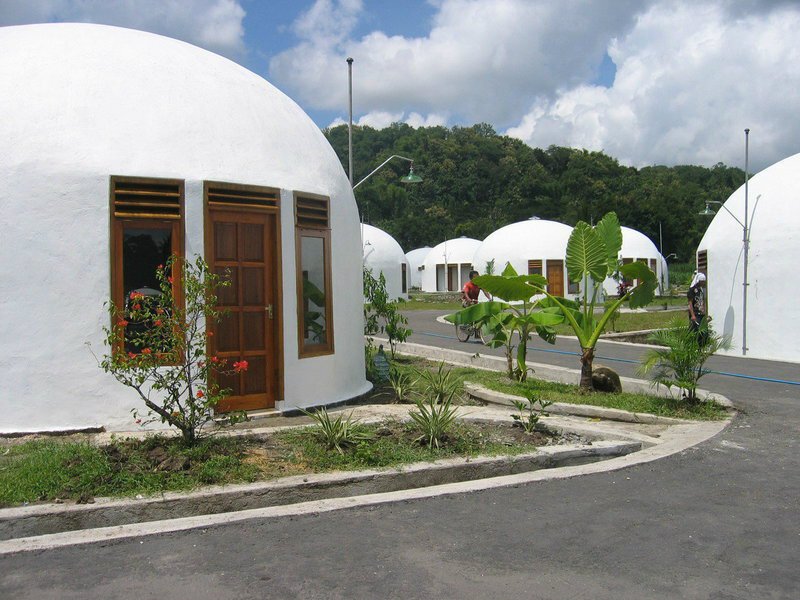Could 'dome homes' be the future of reducing disaster risk?
Loading...
The next time a big storm rolls over the Philippines, at least one city hopes to be prepared.
The southern urban center of Dapitan — about 200 miles from Tacloban, where Typhoon Haiyan did its worst in 2013 — may soon be home to 200 new dome-shaped, disaster-resilient houses, Philippine news site Rappler reported. The project, if finalized in partnership with the local government, will use technology developed by a Texas company that specializes in homes able to withstand storms, fires, earthquakes, and other disasters.
The effort mirrors a broader shift around the world, as governments, international organizations, and communities turn from merely reacting to calamities and disasters toward managing them before they occur.
“Lives can be saved by advance planning — and by building schools, homes, hospitals, communities and cities to withstand hazards,” United Nations secretary-general Ban-Ki Moon said in 2011. “We need to take lessons from cities and countries that have shown how to reduce risk – as well from those less fortunate, whose examples of calamity should give us all pause for thought.”
One such example is the Philippines, a Southeast Asian archipelago that has been battered by a series of devastating storms over the last decade. In 2013, Typhoon Haiyan, the strongest storm on record to make landfall, killed more than 6,000 people and displaced another 4 million in the country’s central region.
Monolithic, a Texas company whose concrete “dome homes” are billed on its website as cost-efficient, eco-friendly, durable, and easily maintained, may provide a solution.
“I saw on TV a father who said that he was hugging a coconut tree while his children were holding his legs and arms, but were slowly carried away by the surge,” Michael Scott, Monolithic’s Philippine representative, told Rappler. “That should not have happened. We could have saved more lives if we were prepared for it.”
‘Disaster chic’
Earthquakes, storms, floods, and other calamities dominate headlines from to Nepal to Vanuatu to Houston. The result has been greater public attention to ways of mitigating a disaster before it strikes instead of scrambling to recover afterward, says Chrysanthe Broikos, curator of the “Designing for Disaster” exhibition at the National Building Museum in Washington, DC.
The display, which runs until September, looks at policies and plans for creating better disaster-resistant communities. Innovation has begun to swing towards solutions that focus on preparedness and prevention, both in the United States and worldwide, Broika says.
“The one thing that is constant is disaster, and people now have a heightened awareness of that,” she says. “They’re asking, ‘What is the best use of my money?’ ‘Why are we rebuilding in a way that doesn’t make sense?’”
David B. South, founder and president of the Monolithic family of companies, says that his dome is an answer. Built on a foundation of reinforced concrete, Monolithic domes are constructed using an airform — a tough, flexible fabric — inflated to the desired shape and size and fortified with polyurethane foam, basalt or lava rock rebars, and a spray mix of concrete the company calls “shotcrete.”
The result is a structure that resembles a 1950s vision of the future, but one that can survive tornadoes, earthquakes, fires, and termites, according to the company site.
It is also energy efficient and “will last for centuries,” Mr. South says. In Monolithic's Philippine project, each unit is estimated to cost about $6,500, Rappler reported.
The company has built domes around the world, including Turkey, Indonesia, and Russia, and South hopes that the design will pick up as awareness of the need for eco-friendly, disaster-resilient architecture grows.
Other efforts are underway, as well. In post-Hurricane Sandy New York, a company called Garrison Architects, in partnership with government groups including the city’s department of emergency management, last year unveiled a prototype for emergency housing that is sturdy and quick to assemble.
In Japan, Architecture Studio Nolla developed a house made of both traditional wood and glulam — short for glued laminated timber, a product both stronger than steel and resistant to moisture, according to the Washington-based Engineered Wood Association.
“Call it disaster chic,” Kelsey Campbell-Dollaghan wrote for Gizmodo.
It's more than just improving design, however. A real shift towards disaster-proof communities means thinking about not only better buildings, but also zoning issues, planning, and things like water access and management, National Building’s Ms. Broikos says. It also asks the fundamental question: To build or not build in a particular area, she adds.
“We can’t just say, ‘build it better,’” Broikos notes. “It’s about trying to think a step or two before you ever get to the building. It’s about being smarter.”








